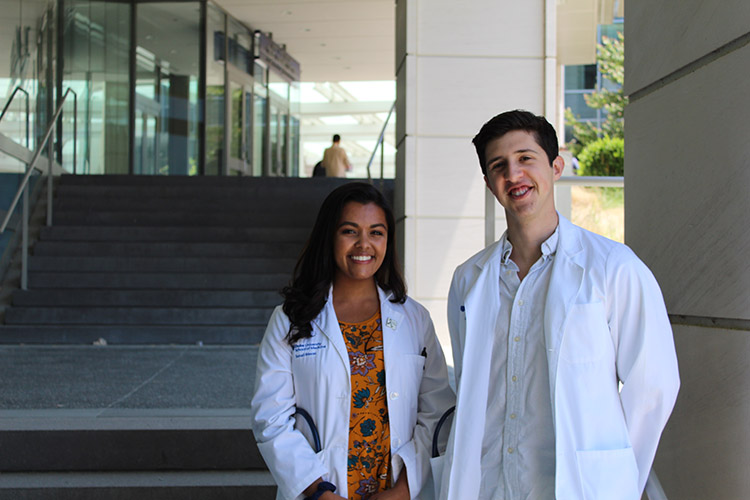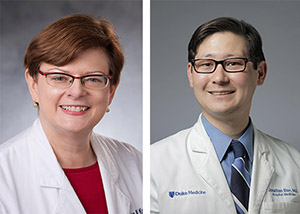
“The B-Word”: Changing a Culture of Burnout Shame
On Duke University’s medical campus, the Great Hall in the Trent Semans Center for Health Education is unusually still as a man walks solemnly to a chair seated on the stage. A palpable silence lingers heavy in the air as the speaker sits to face the audience, slowly lifting his eyes from a manuscript in his lap. He speaks fervently and brightly, but there are tears in his eyes and a discernable quiver with each word he utters.

He tells how his day begins: with coffee, black and in large quantities swigged very quickly on his brisk walk to the hospital. He tries not to spill it on the mildly yellowed white coat he received three years ago as a budding medical student. The morning traffic blazes down Erwin Road as he awaits the beckoning crossing sign to turn white. No, he doesn’t step in front of the van speeding by in the lane just feet from where he stands, but the thought lingers. He smiles politely at a passerby, adjusts his bag over his shoulder and wills away the suicidal ideations that come to him so frequently these days.
Allowing such brazenly raw, disquieting vulnerability to settle, no one in the audience dares move in their seat as he walks off the stage and becomes an onlooker again. Everyone knows that somewhere in the crowd, shrouded in anonymity is the real owner of his story, their words venerated through another’s voice. But no one looks, because it could be any one of us.

The DukeMed Monologues storytelling event, held May 7, was modeled after the Me Too Monologues, an annual show about identity that is written and performed by members of the Duke community. A pair of first year medical students, Sonali Biwas and Michael Rosamilia, participated in the monologues as undergraduates at Duke and wanted to bring the same experience to the School of Medicine. They partnered with nationally renowned medical humanitarian and pediatric oncologist, Ray Barfield, MD, PhD, to incorporate guided writing sessions in Barfield’s medical humanities course that could eventually be read anonymously in a public arena. An experimental change to Barfield’s class, the final reading of the monologues was the concluding project of the Spring 2019 class.
It revealed narratives lined with tropes of inadequacy and failure, loss of purpose and self, depression, suicide, and the rigors of learning to practice medicine: common themes of burnout. Harrowing accounts such as these, from students just at the beginning of their careers, is a painful reminder of the phenomena experienced by medical students, faculty, and staff at all levels of training and practice.
At Duke, our distinct hue of azure is something in which we take great pride; however, in light of a recent resurgence of concern for physicians nationally, we aren’t the only ones occupied with the blues. In media headlines, shocking reports of the prevalence of physician suicide has drawn public attention to what is now known to be a long-standing issue. A simple Google search of “physician suicide” will lead to “burnout” which has come to represent the many tiers of causation, individual and systemic, that contribute to such insidious trends in care providers.
According to 2019 data from the Annals of Internal Medicine, burnout costs an estimated 4.6 billion healthcare dollars annually, continues to contribute to a worsening physician shortage, and correlates with negative patient outcomes, leaving organizations worldwide clamoring to fortify their ranks against this ill-defined entity. Amidst serious questions regarding healthcare reform that continue to percolate through the minds of Americans, “burnout” is making waves outside of hospital walls, placing a much-needed focus on the person behind the white coat and the systems in which they function.
“There has been burnout as long as there have been doctors,” says Jeffrey Baker, MD, PhD, pediatrician and director of the Trent Center of Bioethics, Humanities, and History of Medicine at Duke. Baker explains that many accounts throughout recorded history demonstrate universal themes of emotional exhaustion, depersonalization, and a loss of autonomy. Baker has pored over such accounts and says that the first formal research on the matter occurred in the 1950s due to concern over a shortage of primary care providers. Multiple survey-based studies in the 1960s, including one landmark, multi-specialty assessment by the Journal of Medical Economics, found pediatricians to be the least happy physicians of that time. It is apparent that burnout isn’t new to our era of managed care, electronic medical records, and increasing complexity of systems, patients and regulations, but the question remains: are we dealing with the same experience?
These midcentury studies showed that physicians were unhappy with medically unnecessary tasks, increasing work hours, and low compensation, but they also displayed elements of depression, and felt undervalued and disconnected from their families. This is resoundingly similar to the plight of the modern physician, so why then haven’t doctors spoken up? As anyone who has recently uttered the “b-word” in a hospital knows, it carries a highly-stigmatized connotation and is a surprisingly taboo topic amongst care providers. Admitting that burnout is a problem denotes failure of the system, the individual, or both: a deeply painful truth for those who have dedicated their lives to medicine. So, it is not surprising that there exists a longstanding culture of silent suffering in which care providers hold little dialogue in the burnout debate, relegating it to the discretion of policy-makers and administrators when outcomes and operations become threatened.
As Baker stressed, physicians have been expressing psychological distress since the dawn of the practice and it is perhaps an intrinsic aspect of being a doctor—and the burnout conversation should bear in mind that it is an emotionally involved field. According to data reported at the Annual American Psychiatric Association (APA) Meeting in 2018, physicians exhibit a higher prevalence of mental health diagnoses and suicide than those in any other specific work field or the general population, making the burnout-mental illness corollary a tad chicken-and-egg-like.

As Duke’s Director of Graduate Medical Education, Catherine Kuhn, MD, warns that burnout alone doesn’t lead to depression and suicide and talking openly about struggles in a supportive environment – and sometimes through professional therapy—can help physicians recover from burnout. However, while physicians themselves influenced the now commonly held belief that that mental diagnoses are illnesses and not character flaws, there is still great fear of disclosure in this field, as evidenced by questions about mental illness in many state medical licensing applications.
Kuhn has led by example when it comes to combating these trends in resident trainees, saying that “when leaders who have experienced their own challenges are willing to be vulnerable and share that, it helps.” In her role, Kuhn has been credited for expanding residents’ and fellows’ access to fully confidential wellness resources such as dedicated primary care services and 24/7 behavioral healthcare even before the Accreditation Council for Graduate Medical Education (ACGME) issued regulations on resident wellness.
Despite being a sizable group of physicians within our health system, it wasn’t until 2011 that residents and fellows were included in Duke’s institutional culture surveys and considered in the burnout tally. Helping to set a national precedent for a group of physicians that has been traditionally excluded from burnout metrics, Kuhn has worked diligently to remediate the struggles of medical training at all stages and has helped to advocate for trainees in the burnout conversation.
As an organization, Duke’s goal is not simply to eliminate burnout, but to promote well-being, says Jonathan Bae, MD, Associate Chief Medical Officer for Safety and Quality for Duke University Health System. While the approach to improving well-being is multifactorial and ever-evolving, it starts with assessment and awareness. To that end, Duke Health measures burnout rates as part of organizational culture surveys. And this includes not just doctors but rather all members of the health care team so everyone has a voice in the conversation.
“Establishing the right culture is critical to talk about burnout and to eliminate stigma, especially since it impacts so many of our care givers,” says Bae. “To move toward solutions, we have to focus on both individual drivers and those created by the system itself. But we must also keep in mind the system is all of us. We have a personal responsibility as a person in that system, in the same way the system has a responsibly to support its people.”
From the School of Medicine to the entire Duke University Health System, there is a plethora of resources available to anyone feeling the effects of burnout.
“We have yet to realize our ideal future state,” says Bae, “but our leadership has the right organizational focus to get us there.”
Student Health’s Counseling and Psychological Services (CAPS) is ever expanding for graduate and professional students, while increased collaborations between the Department of Psychiatry and Behavioral Sciences, Personal Assistance Services (PAS), Employee and Occupational Health and Wellness (EOHW), and Duke Primary Care are evolving to provide residents and trainees with easier access to care.
The Duke Center for Healthcare Safety & Quality has trained over 250 “Well-being Ambassadors” across the institution who are working continually to change culture, edify voices, and build up individuals and operations in this endeavor. Meanwhile, hospital services such as “Caring for Each Other” (CEO), a 24/7 pager service connecting providers and staff to social workers and chaplains, helps people exposed to traumatic events immediately gain access to support and connection to other resources.
Trials of narrative writing as an effective medical intervention show that expressive writing offers this same potential, as John Evans, MAT, MA, EdD, knows well. As a writing clinician in Duke’s Department of Integrative Medicine, Evans has worked hard to show that sometimes the best healing comes in the form of pen and paper. Bringing an iteration of a formerly established writing paradigm home to Duke, the approach was trialed for clinical feasibility as a treatment for trauma survivors and was smashingly successful.
As a series of guided writing prompts focused on one traumatic event or stressor, the study showed that the treatment was an easily accessed and efficacious medical intervention for psychological trauma with many potential applications. As part of an ongoing project funded through Duke’s Bass Connections currently investigating the approach as a treatment for the effects of surviving pediatric cancer, the group hypothesizes that the method also has a valuable place in addressing physician and trainee burnout.
“Burnout is like a cake with frosting,” says Kuhn. “The frosting is the yoga classes, therapy dogs, free meals, baseball tickets: the stuff that lets people know that we value them and the work they’re doing. But making a more robust cake so we don’t need a lot of frosting on it … making the cake so tasty so that you don’t even want any frosting! That would be a better strategy to make people enthusiastic for long careers in medicine.”
By striving to recognize that the core of any change is effective collaboration and dialogue between health system leadership and care providers, Duke is implementing cultural changes to enable discussion and openness to the personal experience of burnout. This is exactly the kind of space established through concepts such as Duke Voices and The Medical Monologues. By elevating the many personal narratives of the individuals in a system, voices are allowed to be heard and healing to occur.
Celia Reynolds is a fourth year medical student in Duke University's School of Medicine.
